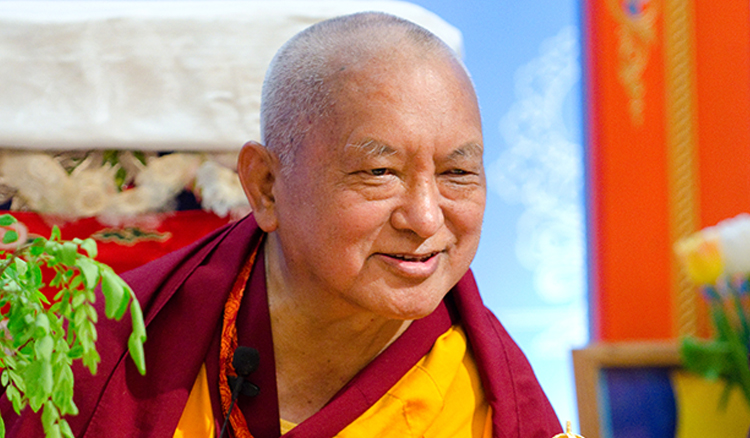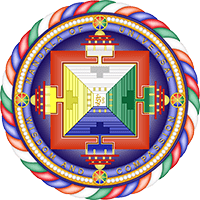
Report by Isabel David
The Guhyasamaja Center is a spiritual center located outside of Washington DC, in Fairfax, Virginia. This spiritual community is dedicated to the practice of Tibetan Buddhism and was founded in 1994 under the guidance of Kyabje Lama Zopa Rinpoche. It is a part of the Foundation for the Preservation of the Mahayana Tradition, which is an international non-profit organization founded in 1975 by a Tibetan monk, Lama Thubten Yeshe. The Guhyasamaja Center is one of 160 centers established by the foundation around the country. The mission of The Guhyasamaja Center is to help all beings fulfill their highest potential of boundless wisdom and compassion inspired by an attitude of universal responsibility. The primary focus of the center is to explore the mind, which translates into understanding and working with our mind to overcome inner causes of suffering and dissatisfaction while cultivating inner causes of happiness. This site will go into detail about how The Guhyasamaja Center was founded, its founder, its roots in Tibetan Buddhism, and its connection to tradition, as well as a close look at the members of this community and the classes and other events offered by the center.
Founders
As previously mentioned above, The Guhyasamaja Center was founded by Kyabje Lama Zopa Rinpoche in 1994. Rinpoche was born in Thangme, Nepal in 1945. When he was just three years old he was recognized as the reincarnation of Sherpa Nyingma yogi, Kunsang Yeshe, the Lawudo Lama. Rinpoche’s home was not far from the cave that his predecessor meditated in for the last 20 years of his life. When Rinpoche was ten years old he went to Tibet and studied meditation in a monastery near Pagari. When the Chinese invaded Tibet in 1959, he was forced to flee to a Tibetan refugee camp in West Bengal India, where he met Lama Yeshe, his mentor. Together the two traveled to Nepal in 1967 and built Kopan and Lawudo Monasteries. In 1974, they began to travel the world and establish centers of Dharma. When Yeshe passed away in 1984, Rinpoche took the reins of the Foundation for the Preservation of the Mahayana Tradition (FPMT) that Yeshe had founded. Many of his teachings have been published, including Wisdom Energy, which he collaborated on with Lama Yeshe, Transforming Problems into Happiness, and Dear Lama Zopa. He has also written thousands of pages of teachings that are available as transcripts on the Lama Yeshe Wisdom Archive website.
For over 30 years, Lama Rinpoche has overseen the spiritual activities of a global network of centers and projects that make up the Foundation for the Preservation of the Mahayana Tradition. During his leadership of FPMT, he has undertaken many projects, one example being The Sera Je Food Fund. This project offers three vegetarian meals a day to all of the 2,500 monks studying at Sera Je Monastery that has been located in South India for the past 26 years. He is known for his vast knowledge and compassion which can be seen through his significant contributions to the many communities he has helped establish and guide.

Lineage and Tradition
The Guhyasamaja Center follows the Tibetan Gelug Tradition of Lama Tsongkhapa, which is the same lineage as the Dalai Lama Tenzin Gyatso. Tsongkhapa was a reformer who through direct instruction from Manjushri (a Buddha figure representing the wisdom and clarity of the mind of all the Buddhas and also transmitted the emptiness teaching from Buddha) and through exhaustive study of Tibetan and Indian Buddhist texts, reinterpreted many basic Buddhist teachings. Tsongkhapa’s works contain a systematic synthesis of Buddhist doctrine which provides a comprehensive vision of the Buddhist path, based on classical Indian Mahayana and Vajrayana. The Gelug Tradition follows him as its founder and possesses many special features that the other Tibetan traditions do not have. The Gelug School is the largest of the four main schools of Tibetan Buddhism. It is based in part upon the older Kadam lineage which is derived from the teachings of Jowo Je Atisha. The Gelug school focuses on ethics and the monastic discipline of the Vinaya as the central plank of spiritual practice. In particular, the need to pursue spiritual practice in a graded, sequential manner is emphasized. Arguably, Gelug is the only school of Vajrayāna Buddhism that prescribes monastic ordination as a necessary qualification and basis in its teachers. Lay people are usually not permitted to give initiations if there are teachers with monastic vows within proximity. In conclusion, the key teachings of the Gelug tradition are Lamrim, a Tibetan Buddhism form for presenting the stages to achieving enlightenment, and the systematic cultivation of emptiness.
Relationships with Buddhist Communities – FPMT
To fully understand the traditions and mission of The Guhyasamaja Center, one must take a close look at The Foundation for the Preservation of the Mahayana Tradition. As mentioned above, the Foundation for the Preservation of Mahayana Tradition refers to an affiliated network of city centers, retreat centers, monasteries, nunneries, publishing services, hospices, and other service and project functions to achieve the FMTP mission, which is to continue to preserve the Mahayana Tradition globally. The foundation aims to accomplish this mission by creating opportunities to listen, reflect, meditate, practice, and live out the teachings of Buddha while spreading the Dharma to other sentient beings. They are inspired by a universal attitude of responsibility and service and are committed to creating harmonious environments for all beings. Though their services primarily focus on serving Buddhist communities, their reach is not limited to that. FPMT is a non-profit religious corporation that was incorporated in the State of California, which is where the international office and headquarters are located. In 2000, the organization created an ethical policy, which guides all of its affiliated organizations. This ethical policy is important to note when looking at the structure of The Guhyasamaja Center.

Teachers and Community
All are welcome to The Guhyasamaja Center’s classes, and there are many resources on the center’s website for new participants. This resource makes attending the center and learning the practice accessible and approachable to those who may not yet be familiar with it. Though membership is not a necessary ground to attend classes at the center, The Guhyasamaja Center encourages membership as a means to provide Dharma teaching and to expand its services. In short, the membership option is a way for those who have benefited from the center to demonstrate generosity and gratitude towards the teachers of the center. The center currently has eight teachers, including Lama Tsnogkhapa, the lineage founder, the 14th Dalai Lama Tenzin Gyatso, Kyabje Lama Zopa Rinpoche, spiritual director, and Gyumed Khensur Rinpoche Lobsang Jampa, a teacher in the community. The other four teachers became Buddhist in North America and play a more physical role within the center. Their contact information is listed on the website and they all talk about their journey to find The Guhyasamaja Center. From outside sources, one can gather that most of the community members that take part in practice at the center are from the surrounding areas in Northern Virginia.
Classes and Events
The Guhyasamaja Center offers a wide variety of classes and events that are open to all. The events and classes range from introductory classes like “Buddhism 101” to more hands-on studies of the practice that go into greater detail of the Buddha’s teachings. There are classes on topics such as karma, bodhichitta and emptiness, medicine pujas, tantric initiations and meditation retreats. Many of these classes are also offered online, which creates a safe option for those who cannot attend in person due to the current COVID-19 global pandemic. In addition to this, the center will host events such as the Dharma book club, movie nights, and other social gatherings, which provide an opportunity for community members to strengthen their bonds and friendships while contemplating teachings and cultivating harmonious environments. Lastly, the center has celebrations for the major Tibetan Buddhist holy days so that the community can celebrate together.
Funding
Finally, it is important to address where The Guhyasamaja Center gets its funding. The center is entirely run by volunteers with the donations of those who are a part of the community. All of their classes and events come without charge and are operated on a dana basis, which is the Sanskrit word for generosity. They emphasize that all Dharma teachings are free. Within their website, there is a tab labeled “Practicing Generosity” where they have three ways to practice generosity: donations, membership, and volunteering. They also have three different financial statements on their website to promote financial transparency.
Work Cited
“The Guhyasamaja Center.” Guhyasamaja.com, http://guhyasamaja.org/.
“Foundation for the Preservation of the Mahayana Tradition – Home.” FPMT, 12 Oct. 2021, https://fpmt.org/.